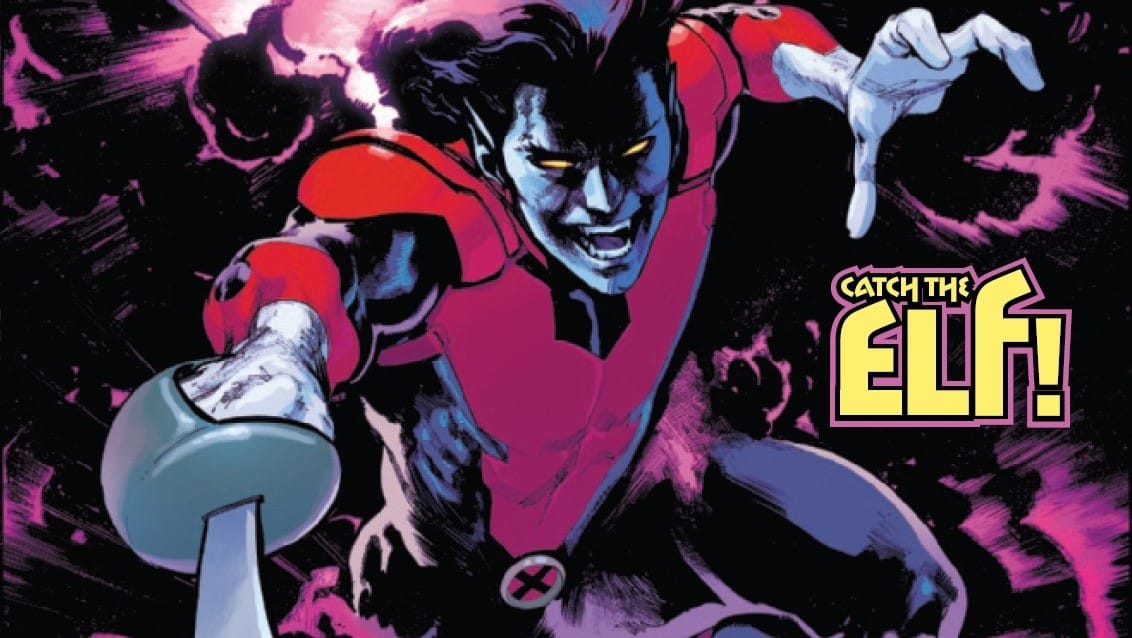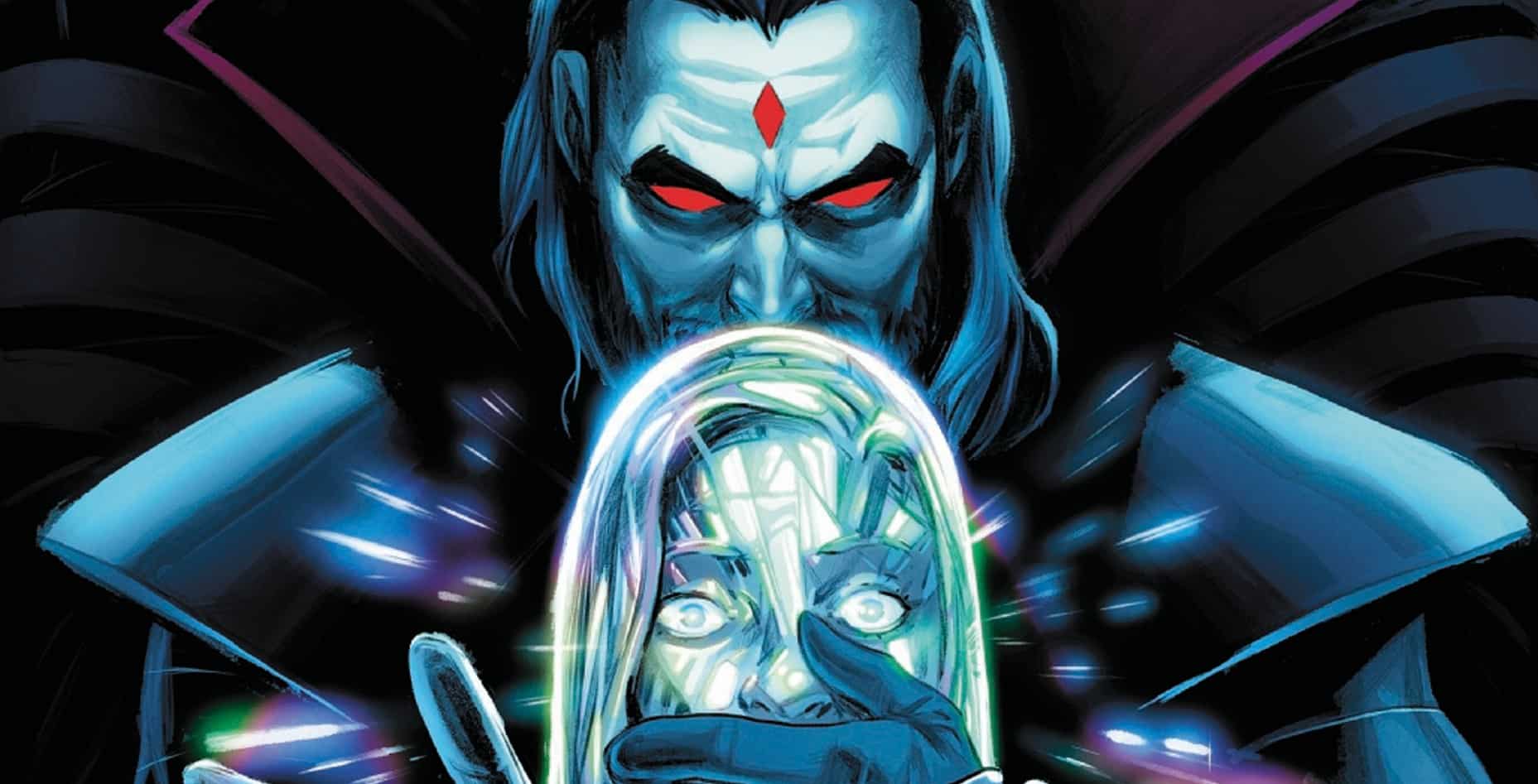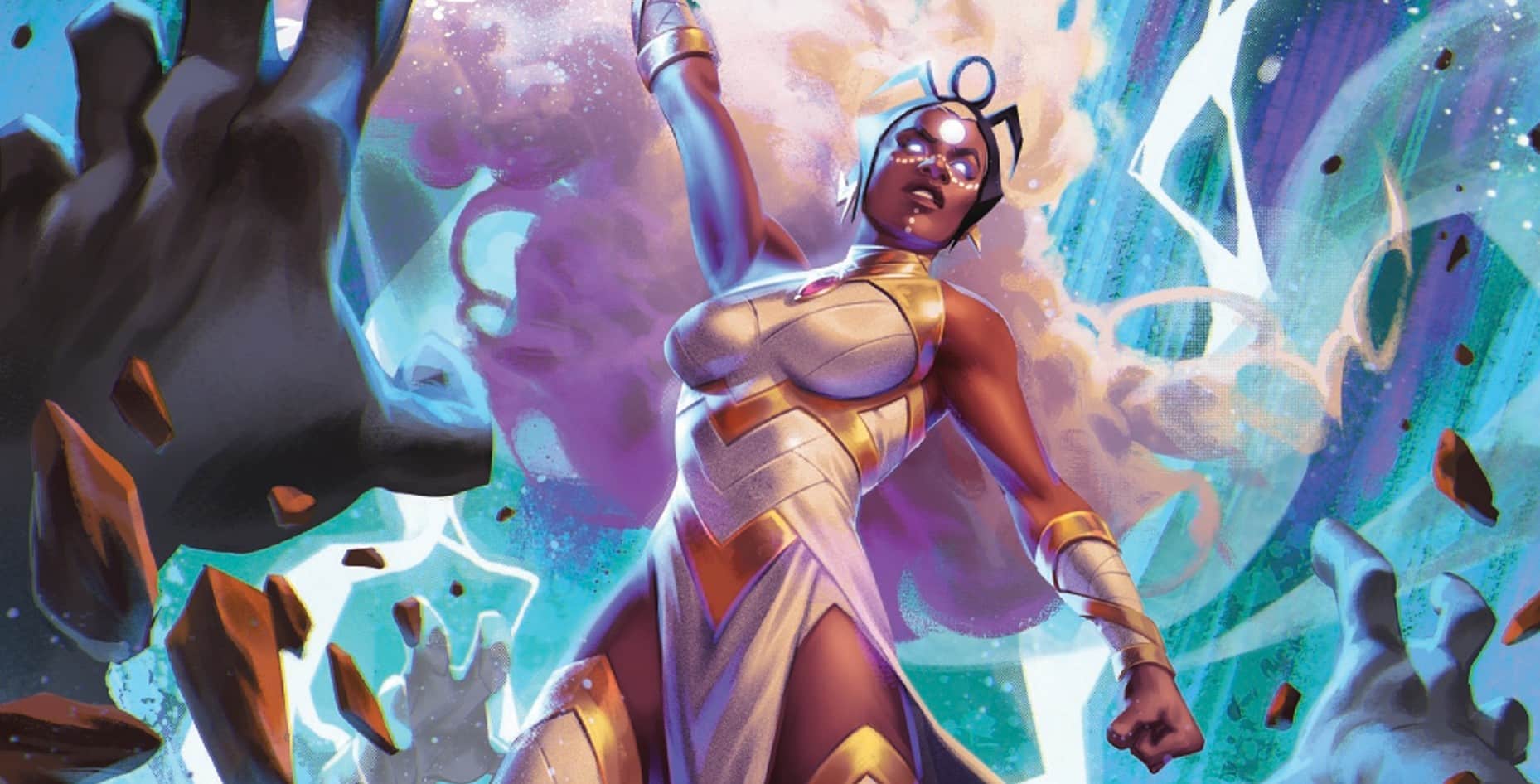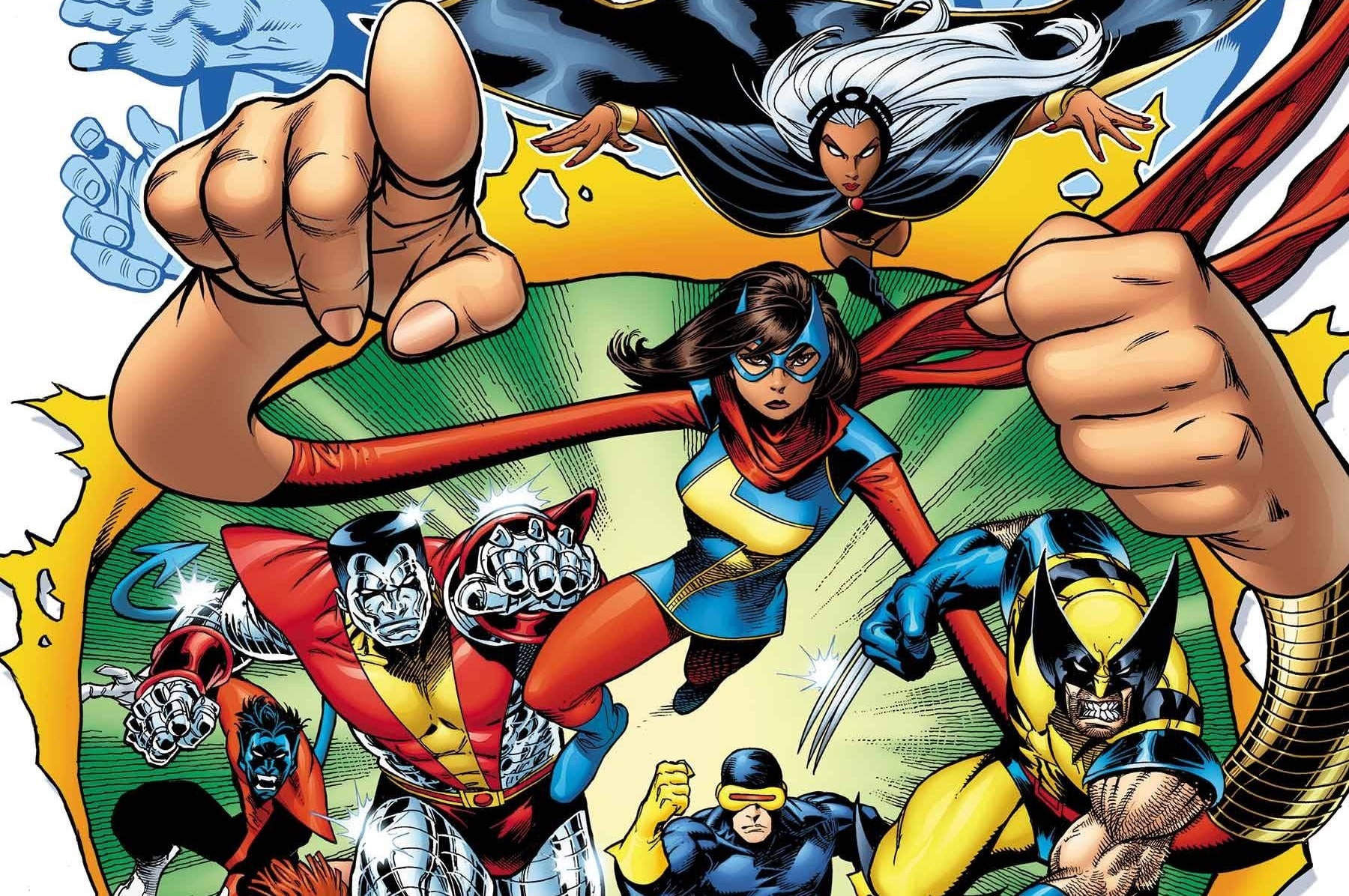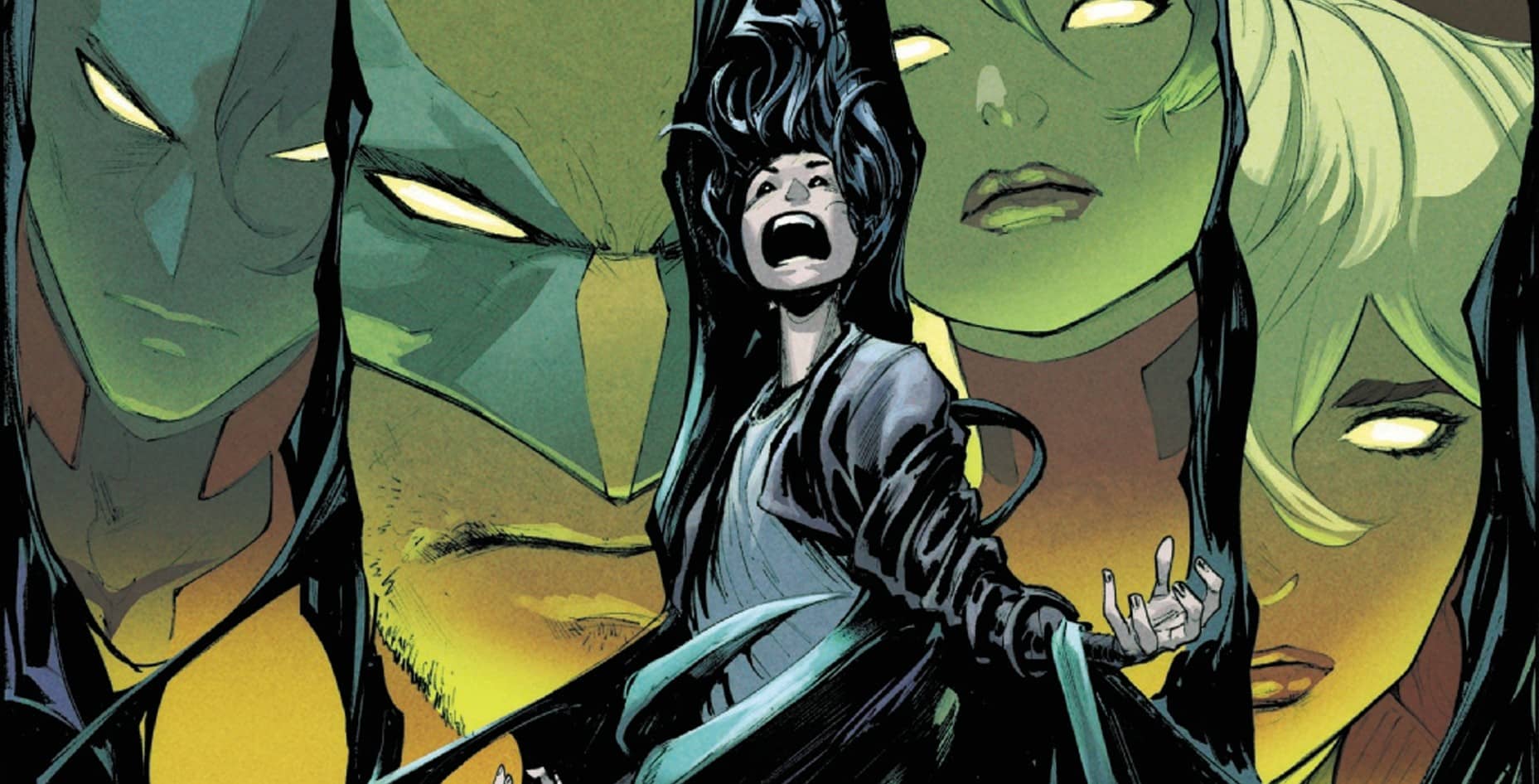CATCH THE ELF! When new, lethally powerful and completely untrained young mutants show up on Rogue’s doorstep with no knowledge of how they got there, a grieving Rogue seeks to take Xavier’s place in guiding them to the light, while darkness from the past returns to destroy the X-Men, one at a time. Uncanny X-Men #3 is written by Gail Simone, drawn by David Marquez, colored by Matthew Wilson and lettered by Clayton Cowles.
Jake Murray: Zauberhaften, readers, and call me “Jake,” danke. Today’s mission? Review Uncanny X-Men #3. Simple as brown sugar pie. As ever, Anna Peppard is here to help me out a good bit. Other than exhausted after reading that intro, how are you today, Anna?
Anna Peppard: Is it Uncannytime already? Lord knows I love making more mutants as much as the next elf, but it feels like I’m running a Danger Room gauntlet trying to keep up with this bevy of X-books lately. But catching up with Kurt Wagner is usually worth it. So are the backstories of our new recruits in what I’m comfortable calling the most compelling installment of this series to date. The game is afoot, my friends. Let’s get to reviewing.
Battle for the Belt

Jake: At the spiritual core of Uncanny X-Men so far, we have Rogue and her new charges, The Outliers. While the plot is being driven from other, perhaps less effective storylines, the dialogue between Rogue and her team is warmer’n a sunrise over the prairie on a midsummer’s day. The tenderness between old friends the X-Men, particularly in the scene between Rogue and Wolverine, is worth the price of admission alone. It works particularly well because it contrasts with the slightly more detached feel to their burgeoning relationship with the Outliers. It works even better because Kurt breaks through that skepticism almost immediately when he bursts onto the scene.
After Logan announces his departure from the team to go and be one with nature for a bit (different woods from his solo series), it’s clear that the role of mentor falls squarely on Rogue’s shoulders. Who else is going to do it? Jubilee just got here, and is uncharacteristically quiet in this issue, Kurt will seemingly port in and out as he sees fit, and Marquez makes it very apparent that Gambit sleeps in longer than most of the teenagers, so nothing doing there.
Anna: While I enjoyed the scene between Rogue and Wolvie – due in no small measure to Marquez’s lovely framing and character modelling and Wilson’s evocative colors – there is, as you alluded to, an unfortunately repetitive quality clinging to the golden glow of this moody morning. Not only is Logan, as you note, concurrently retreating to a different wilderness for different reasons in a different series, we’ve also seen him pull this routine so very many times before. Rogue surely should laugh at his secondhand goodbye to Jubilee, who will probably also laugh, since Logan’s been pulling this gimmick on her for 30 years of comics and the bulk of her formative years. Regardless, before he goes, Logan offers his insight on the Outliers, setting up one of the most compelling parts of this comic.
Jake: The purpose of the issue is, ultimately, to tell the origin story of the four Outliers, for which Gail Simone uses a combination of the tried and trusted Danger Room framework and a group share situation. The interspersing of shifting first-person narrative with the fun action sequence of the students trying to take a belt off Nightcrawler is slightly awkward but ultimately gets the job done. What did you make of the origin stories, Anna? Did any stand out to you in particular?
Anna: I agree that this exposition, which features two layers of flashbacks set amid an action sequence, should have been awkward, but the art team once again takes the cake for making this narrative heavy lifting look effortless. Overlapping, weaving panels and watercolor-y swatches show the ways in which the past bleeds into the present, affecting how each Outlier sleeps and fights and sits around a sharing circle. Yet clear stylistic delineations between the panels set in the past and those set in the present let us follow the kids chasing a teleporter through an obstacle course without getting lost in a sea of sentimental remembrances or brimstone haze.
I liked all of the origins a lot, which did a good job establishing the contexts of these characters and how their powers relate to their experiences and the personalities that have grown from those experiences. And each has a requisite hit of darkness without exploiting too many predictable tropes of childhood abuse and trauma. But if I had to choose a favorite origin, I’d have to go with Calico’s.
This origin arguably makes the best use of the comics form to earn its depth. Almost every panel of Calico’s flashback juxtaposes her dialogue with a contradictory image, suggesting some part of her knows the truth but isn’t yet ready to share it, with a crowd and maybe even herself. (Is she a mutant or isn’t she?) Lines about her being wrapped in her mother’s love are paired with images of her seated at the head of an empty table in a cavernous dining room. And she certainly doesn’t say she saved her horse while letting the estate burn. But we know she did, because we see it. We also see how Calico crowns the story with a calmly beatific smile, which becomes, in context, at least as sinister as Sarah’s claws. Speaking of Sarah, elements of Calico’s origin lend credence to a theory Jake discussed in our last review, about Sarah perhaps being Calico’s mother. But I’ll leave that alone for now.
Jake: I can’t believe I’m saying this, but I think Deathdream’s origin story is actually too metal for me. Anyway, I’ll join you in marveling again at the art team. Wilson’s colors create the sort of beautiful autumnal glow that perfectly complements Marquez’s stunning pastoral landscapes, which gradually get darker and darker as Logan goes deeper into the woods. The Southern gothic horror tropes are gradually creeping in, which brings us to our next plot point.
Xavier All Along

Jake: Things have moved rather quickly after last issue’s cliffhanger reveal that the monster hunting children in the woods is in fact Charles Xavier’s ex-girlfriend, Sarah. In fact, she’s gone majorly off script, breaking into Charles’ prison cell to torment him and deviating from Warden Ellis’ plans. We learn here that her intent is to murder the children, presumably The Outliers, but that she can’t sense them as she can others. It would appear that the professor is protecting them from afar.
While it’s odd that she goes from being Ellis’ lackey to rebelling so quickly, I don’t mind that it’s moving at this pace because I’m not particularly keen to linger on this plot for too long. In our review of the last issue, I raised some concerns about the way the story was going in that I felt there was an implication that it was her loss of motherhood that had made her monstrous, which is a well-worn, problematic trope, particularly in horror and fantasy fiction that I’m going to note here again. The very strange ending to the scene between her and Charles in which she asks, pretty much out of the blue, “Do you miss my womb, Charles?” implies that this could be the case, but I’m always wary of jumping to conclusions in serialized storytelling, because there’s every chance Simone could subvert our expectations in the next issue.
Anna: The monstrous mother trope is a tricky one. Sure, it’s got a problematic history. But feminist writers also have a long history of using the trope against itself, underscoring the power of monstrous mothers to both reflect and deflect misogyny. Because who’s most afraid of monstrous mothers? Misogynists, mostly. When monstrous mothers manifest as vengeance against the misogynist myths that make them, they can unmake them (or at least punish their would-be masters in satisfying spectacles of unruly feminine rage). At this point, I really can’t say which tack this story will take. But my money’s on Charles making yet another hubris-laden error in judgement.
Jake: A tale as old as time, unlike Logan’s slogan “Not. Dead. Yet.” which I’m assuming is a reference to Warren Ellis’ arc of the same title but isn’t one that I’ve heard very often, I have to say. In any case, Marquez’s art in the fight scene between Sarah and Wolverine at the end of the issue is fantastic. He adopts a figurative style, expressed through exaggerated approach to claws and limbs alike, which stretch and slice across and through every panel. These three pages have a ferocious velocity to them, ending on a close-up of a subdued and terrified Wolverine, who somehow makes a psychic death cry to Rogue (my money’s on that Xavier guy again). I found the pacing to be a little squeezed right at the very end, which means the cliffhanger doesn’t quite have the impact of the previous issue’s closing scene, but it was yet another example of Marquez’s exceptional work.
Kurt Corner

Jake: It’s time to visit Kurt Corner (Nightcrawler Nook? Bamf Basement?).
Anna: The real name on Nightcrawler’s OnlyFans is obviously Brimstone Love. (Yes I know that name is already taken, no I’ll never get over it already being taken.)
Jake: Incredible. Uncanny X-Men #3 sees the first feature cover for everyone’s favorite Fuzzy Elf/False Pirate/False Priest in the From The Ashes era, as well as some notable revelations about Kurt’s social life away from the X-Men. Isn’t it fortunate, then, that I have Nightcrawler’s unofficial PR manager with me today. Anna, what did you make of the Nightcrawler action in today’s issue?
Anna: Pretty generic outing for my guy, but that’s fine; Kurt works well in this role, tutoring kids through humor, joy and compassion, and if it ain’t broke, don’t fix it. I did have to chuckle a bit at Deathdream’s “do you want to really see Heaven” taunt, since Kurt has, of course, not only already seen heaven, but decided it was boring and chose to fall, first to hell to fight the devil he thought was his father, then back to Earth into a body made of maggots. But I assume Deathdream is less up to speed on Mr. Wagner’s continuity.
Kurt’s compassion for furries isn’t a surprise; he is, after all, centrally defined by being a lover, not a hater, and adores any excuse for a bountiful bash. But I rather think some furries would be disappointed to learn his fursuit isn’t a suit.
Anyway, now that we’ve caught Kurt, maybe we can keep him. While I’m enjoying the focus on Rogue’s perspective, I do sometimes wish we were getting a bit more insight into what’s drawn the other members of this team toward each other. The supposed rift between Cyclops and Rogue – and I guess between Rogue and most mutants, who are supposedly declining her calls – remains unclear in ways that keep me from investing in the mission as much as I want to, and make some of the lines about home and family ring hollow.
Jake: Completely agree. I’m a big Rogue fan, but she is so prominent in this series so far that beyond a couple of flashy moments, we’ve heard very little of Jubilee or even Gambit. Fundamentally though, despite the volume of internal monologue, I can’t perceive what Rogue’s position on the current state of mutantkind is, let alone how it contrasts with Cyclops’. Even Schism, for all its flaws, entrenched two strong opposing positions early on so the reader could get a sense of what battle lines were being drawn and why. It also gave us Cyclops in a loincloth.
Anna: At the end of the day, while I deeply enjoyed the time we spent with The Outliers in this issue, more than a third of the comic is taken up by the solo adventures of two of the X-franchise’s most overexposed characters, Charles Xavier and Logan. It feels like we’re getting closer to defining this team and title’s identity, but three issues in, we’re not quite there yet. For now, though, I remain content to hope we’re heading somewhere.
Jake: Same here. If my guiding question for the longevity of a series is “do I look forward to spending time in this world, with these characters?” then the answer here is yes. There’s a bit to do plot-wise, but I don’t think the amount the series has pulled off and set up so far should be overlooked.
X-Traneous Thoughts
- What’s with Logan calling Rogue “Moonbeam”? Is that a new thing? Also, how does Sarah know about it? If she’s psychic, this would put a very interesting complexion on her relationship with Charles in those early days.
- Last month, we mentioned the possibility of the name “Warden Ellis” being a play on “Warren Ellis.” There’s also that reference to Ellis’ “Not Dead Yet” story arc in this issue. If these references are intentional, I don’t know to what end. Gail Simone was a professed friend of Ellis before his downfall, but subsequently expressed support for his victims. But hey, life is full of coincidences. Maybe this is one of those.
- Just so I can say I got there first, I’m putting money on the horse being responsible for burning down the Simon-Pinette estate. Horses deserve a chance to be evil.
Buy Uncanny X-Men #3 here. (Disclaimer: As an Amazon Associate, ComicsXF may earn from qualifying purchases.)

